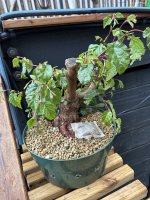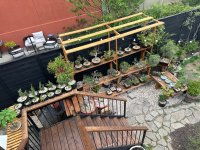Greenpoint Vince
Yamadori
Hello all,
I aquired this Korean hornbeam a few months back. Field grown in California. I’m in Brooklyn NY. It put on a good amount of growth at the start of the growing season but lately it’s been looking a little droopy. It’s rained quite a bit this spring so I drilled some holes in the side of the pot to help aeration. I thought placing it in the sun would help but it really did not like that and got even droopier. It’s in a shady spot now with fingers crossed. Any ideas out there?
As always thanks in advance!
Vince
I aquired this Korean hornbeam a few months back. Field grown in California. I’m in Brooklyn NY. It put on a good amount of growth at the start of the growing season but lately it’s been looking a little droopy. It’s rained quite a bit this spring so I drilled some holes in the side of the pot to help aeration. I thought placing it in the sun would help but it really did not like that and got even droopier. It’s in a shady spot now with fingers crossed. Any ideas out there?
As always thanks in advance!
Vince





